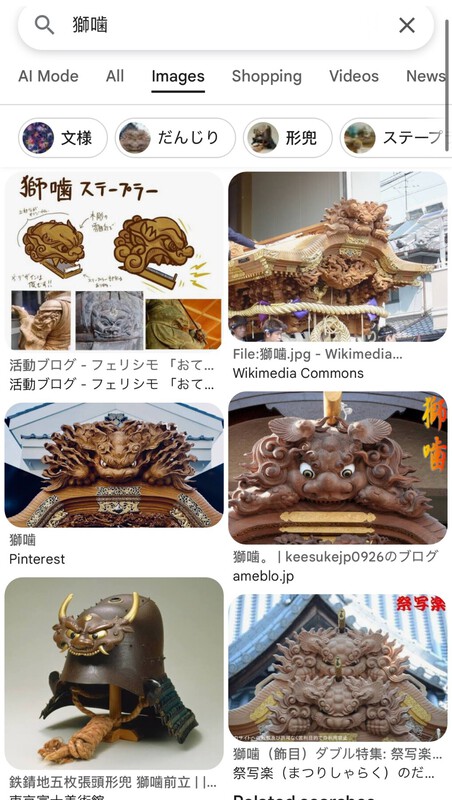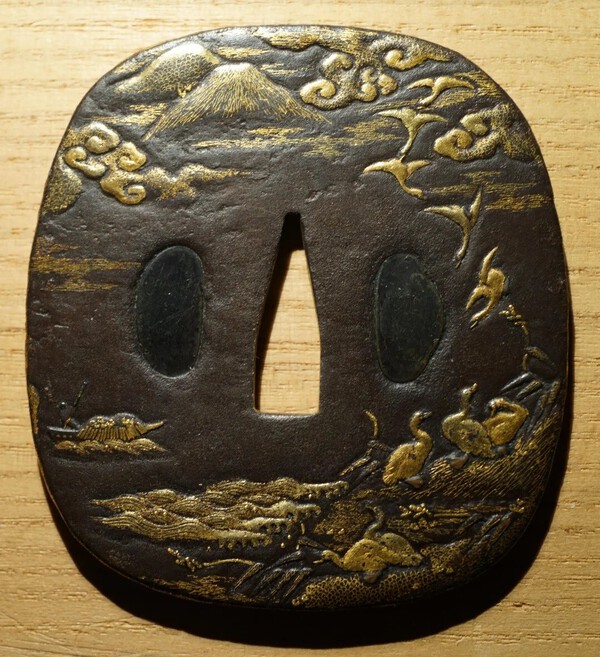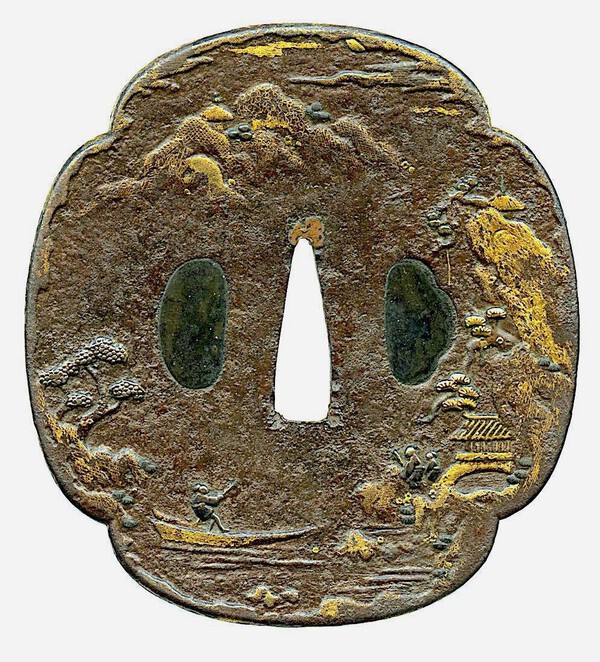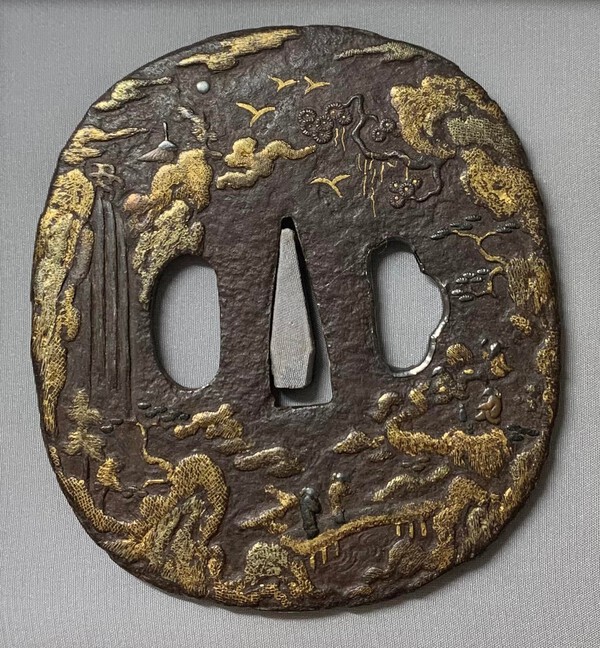-
Posts
562 -
Joined
-
Last visited
-
Days Won
2
Tcat last won the day on December 31 2024
Tcat had the most liked content!
About Tcat

Profile Information
-
Gender
Male
-
Location:
London / LA
-
Interests
Motorcycles, Art, Fishing
Profile Fields
-
Name
Alex
Recent Profile Visitors
The recent visitors block is disabled and is not being shown to other users.
Tcat's Achievements
-
Thanks - there are a couple of tsuba posted here on the board, but I think the school only really lasted two generations as far as sword fittings go. After the sword ban the shop converted to other decorative damascene work - cigatette cases, bonbonnières etc. There's an article about the history of the shop up on the smoking samurai website under S. Komai.
-
This late Edo period Kyoto koshirae comprises a coherent suite of Komai-school gold hon-zōgan fittings executed in the classic Unryū cloud-dragon motif. During the late Edo and Meiji periods the Komai school developed the highly refined iron-ground gold inlay technique that would later become internationally recognized in their production of inlaid boxes, cigarette cases, and decorative objects. The fuchi is signed Yoshitaka saku, identifying the maker as Komai Yoshitaka. The accompanying tsuba bears a kinzōgan signature Tadanobu saku, and employs a closely aligned decorative style and gold coloration, suggesting manufacture potentially within the Komai milieu or by an affiliated craftsman. Gold menuki depicting two pairs of mandarin ducks are mounted on the tsuka under black silk ito. The saya is finished in bengara-nuri (iron-oxide red lacquer) applied over a tōmaki rattan spiral wrap. This results in the characteristic helical relief beneath a high-gloss finish associated with Kyoto workmanship of the late Edo–Bakumatsu period. Playing with the phone camera and sharing these attractive mounts just for fun. I have seen a sister Fuchi/Kashira set mounted on a well-known Kiyomaro sword, so take them to be high class examples of the style. Questions / comments welcome.
- 4 replies
-
- 14
-

-

-

-
Hi Michael, Your sword is signed 平安城藤原國次 - Heianjo Fujiwara Kunitsugu. He was a smith who worked in Echizen province during the 1600s Shinto era of swordmaking, and there were several generations of the smith. There is some repairable damage to the blade and fittings. The fittings are corroding and the metalwork of the fuchi, kashira, tsuba and seppa require stablization and repatination. The scabbard seems to be lacking some of its hardware and the lacquerwork is damaged, these would need to be repaired in order to preserve the condition of the blade and prevent further deterioration. It can be difficult to give a definitive valuation when work needs doing. Realistically, your best bet is to look at action results, such as ebay, and compare the hammer price for blades of a similar type, age and condition. Alternatively, ask yourself what it would cost to replace according to what you see offered on the market. Replacement value and sale value are often not the same thing in the world of art and collecting.
-
Makes one wonder just how much editing goes into dealer / auction / online catalogue photos. Sometimes I feel that a simple phone camera with unedited photos is more honest.
-

Understanding Samurai Disloyalty
Tcat replied to John C's topic in General Nihonto Related Discussion
That is false. While Inazō Nitobe’s Bushido: The Soul of Japan (1899) popularized the term in the West and reframed it as a moral philosophy, the word bushidō itself long predates him. It appears, for instance, in the Kōyō Gunkan (c. 1616) and in writings by Yamaga Sokō and Daidōji Yūzan, where it already referred to the “proper way or path of the warrior”. So, it can be said that Edo-period samurai were familiar with both the term and the ethical ideals it denoted…though I can concede that its meaning evolved over time. However, Nitobe certainly did not invent the concept bushidō; he reinterpreted an existing Japanese concept for a Western audience within a Meiji-era, Christian-humanist framework. Meanwhile, the groundwork for the formation of the concept of bushidō was done in Kamakura and Muromachi periods, its ethical substance was codified under terms like kyūba no michi and shidō, and is well-attested to in period texts and chronicles eg. Heike Monogatari (平家物語, early 13th c.), Taiheiki (太平記, 14th c.), Chikubashō (竹馬抄, 1383) etc. -

Juyo swords found in Shin Gunto Koshirae
Tcat replied to PNSSHOGUN's topic in General Nihonto Related Discussion
The sword world is so ''small and getting smaller'' that for the sake of its own continuation simply can't afford to pick and choose. Meanwhile for the record, exclusionist policies while romantic are doomed to eventually fail and their proponents destined for pariah status. -

Juyo swords found in Shin Gunto Koshirae
Tcat replied to PNSSHOGUN's topic in General Nihonto Related Discussion
It's very simple really. When you're good at something, people who know quality will find you and won't care if you are 'gaijin' or not. -
Some further specification on this oni subject… I think in this case they should be described as “biting lion heads” (獅噛). The theme was recently shared on the Met’s arms and armor page..I include a screenshot of the search term in google. 🦁
-
I will preface the following remarks with the caveat that as enthusiasts or professionals I believe we ought to do what we can to try to preserve these objects. Furthermore, I am not encouraging willy-nilly experimentation, but the deft and sympathetic hand of someone who cares. With that said... In the case of old tsuka cores and itomaki which have become so dusty and beatup as to warrent consideration for recycling, a final lease of life may be given with a few strategically and carefully placed microdots of superglue, followed by a gentle stage-by-stage cleaning of the ito and samegawa with a soft bristled toothbrush. You may be surprised at the results you can achieve with some patience. First nudging the ito around, working with what you have left to get its most appropriate position before tacking it down. Its already broken in a few places and if you want it properly functional again you would likely have to build a new core and rewrap it. Be wary that old silk can become much like a solid powder, similar to a block of ladies' foundation that can be brushed and wiped away into oblivion if one is not careful. Its fragility will depend on its age and storage conditions, but textural integrity is almost impossible to discern from photos alone. Done carefully, stage by stage without soaking it, dabbing a soft bristled toothbrush with a water and mild soap mix, rinsing then drying off each patch with absorbant paper as you go is the only way I know of, and works pretty well. Other solvents are too harsh. After removing as much of the moisture as possible with absorbant paper, to get it completely dry you can just leave it at room temp for a few days rather than any extra heating or airflow.
-
They are demons, not dogs. The 'front-on' pose is classic, and these kinds of menuki are often made in identical pairs, in the same way that most tsubogasa style menuki are also made in identical pairs - its quite normal and proper. Probably late edo oni menuki, not repurposed pouch ornaments and not oversized for the application, just right for a fancy shin-shinto or Meiji look... Heres an example similar design, yours are nicer..
-
You know, I wanted to say this and I find it a very plausible explanation. I want to change my guess now
-
Here are tthree examples of what are to me 'classic non-dragon jakushi'. The work gives a similar vibe - however the seppadai does indeed look 'namban'. Meanwhile it is not unheard of to find namban tsuba that were given a beauty treatment with gold and precious metals. Anyway, the style is similar enought to make me wonder.








.thumb.jpeg.fad864d31e1088b137cbcec3183d285c.jpeg)


